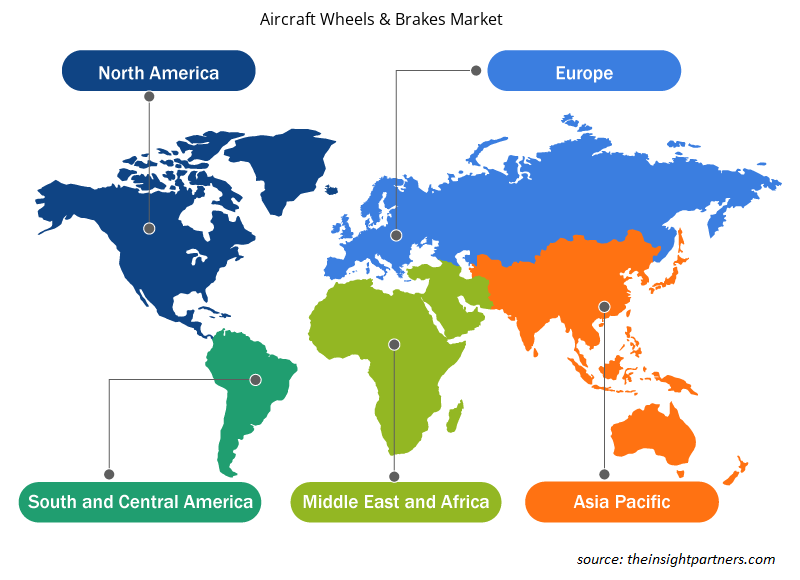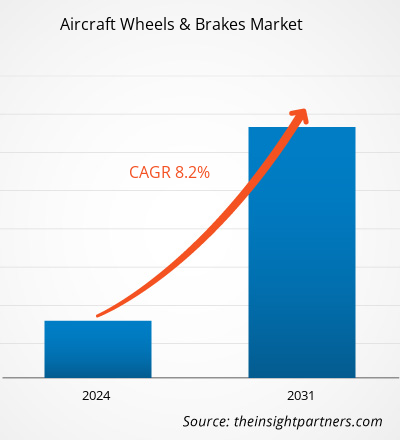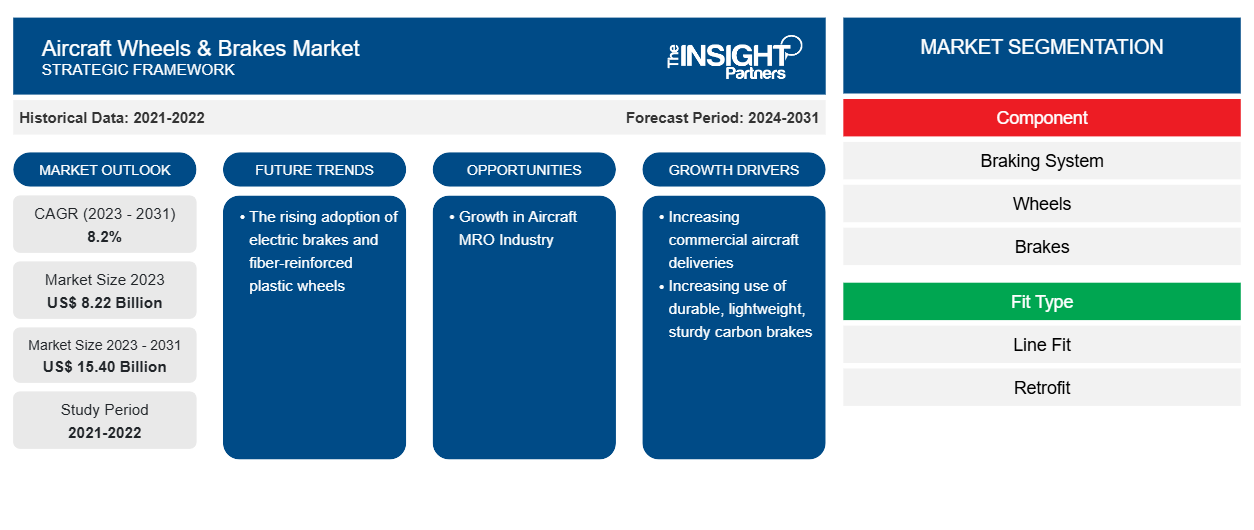항공기 휠 및 브레이크 시장 규모는 2023년 82억 2,000만 달러에서 2031년까지 1,540억 달러로 성장할 것으로 예상됩니다. 이 시장은 2023~2031년 동안 8.2%의 CAGR을 기록할 것으로 예상됩니다. 전기 브레이크와 섬유 강화 플라스틱 휠의 채택 증가는 시장의 주요 추세로 남을 가능성이 높습니다.
항공기 휠 및 브레이크 시장 분석
항공기 휠과 브레이크 시장은 Honeywell International Inc, Parker Hannifin Corporation, Safran Group, Crane Aerospace & Electronics 등과 같은 잘 정립된 업체가 주로 주도하고 있습니다. 항공기 제조업체 사이에서 휠과 브레이크에 대한 수요가 크게 증가하고 있습니다. 그러나 대부분의 계약은 잘 정립된 업체에 수주됩니다. 또한 이러한 휠과 브레이크를 제조하려면 관리 기관에서 정한 여러 표준을 준수해야 합니다. 여기에는 다양한 인증 획득과 R&D에 대한 상당한 투자가 포함되며, 이는 이 분야에 신규 업체가 진입하는 것을 제한합니다. 따라서 현재 상황에서 신규 진입자의 사업에 대한 위협은 높지만 항공기 생산량이 증가함에 따라 새로운 업체의 등장이 예상됩니다. 이는 여러 중소 항공기 제조업체가 경쟁력 있는 가격으로 첨단 기술 휠과 브레이크를 제공하는 신규 진입자로부터 휠과 브레이크를 조달하기 때문에 신규 진입자에 대한 위협을 낮출 것으로 예상됩니다.
항공기 휠 및 브레이크 시장 개요
항공기 휠 및 브레이크 시장 생태계는 원자재 및 구성 요소 공급업체, 항공기 휠 및 브레이크 제조업체, 항공기 제조업체 및 최종 사용자 등 다음과 같은 이해 관계자로 구성됩니다. 항공기 휠 및 브레이크 제조업체는 강철, 알루미늄, 마그네슘 합금 및 탄소 섬유 재료와 같은 원자재 및 구성 요소를 조달하고 센서 및 액추에이터와 같은 구성 요소는 다양한 원자재 및 구성 요소 공급업체에서 조달합니다. 항공기 휠 및 브레이크 제조업체는 원자재 및 구성 요소를 조립하여 완제품으로 생산합니다. 항공기 휠 및 브레이크 제조업체는 항공 당국, 원자재 공급업체, 항공기 제조업체 및 최종 사용자와 협력합니다. 시장에서 운영되는 저명한 업체로는 Collins Aerospace, Honeywell International Inc, Safran Group 및 Parker Hannifin Corporation 등이 있습니다. 또한 항공기 제조업체는 위에 언급된 업체로부터 휠과 브레이크를 조달하여 라인 피팅 활동을 통해 항공기 함대에 설치합니다. 마지막으로 항공사, 다양한 국가 군대 및 MRO 서비스 공급업체와 같은 최종 사용자는 항공기 휠 및 브레이크 MRO 활동에 대한 계약을 체결합니다. MRO 서비스 제공업체는 항공기 휠 및 브레이크 MRO에 대한 수요가 계속 증가함에 따라 지속적으로 서비스를 제공하기 위해 시장 참여자로부터 휠과 브레이크를 지속적으로 조달합니다.
귀하의 요구 사항에 맞게 이 보고서를 사용자 정의하세요
이 보고서의 일부 또는 국가 수준 분석, Excel 데이터 팩을 포함하여 모든 보고서에 대한 사용자 정의를 무료로 받을 수 있으며 신생 기업 및 대학을 위한 훌륭한 혜택과 할인 혜택을 이용할 수 있습니다.
-
이 보고서의 주요 시장 동향을 알아보세요.이 무료 샘플에는 시장 동향부터 추정 및 예측까지 다양한 데이터 분석이 포함됩니다.
항공기 휠 및 브레이크 시장 지역 통찰력
Insight Partners의 분석가들은 예측 기간 동안 항공기 휠 및 브레이크 시장에 영향을 미치는 지역적 추세와 요인을 철저히 설명했습니다. 이 섹션에서는 북미, 유럽, 아시아 태평양, 중동 및 아프리카, 남미 및 중미의 항공기 휠 및 브레이크 시장 세그먼트와 지리에 대해서도 설명합니다.

- 항공기 휠 및 브레이크 시장에 대한 지역별 특정 데이터 얻기
항공기 휠 및 브레이크 시장 보고서 범위
| 보고서 속성 | 세부 |
|---|---|
| 2023년 시장 규모 | 82억 2천만 달러 |
| 2031년까지 시장 규모 | 154억 달러 |
| 글로벌 CAGR (2023-2031) | 8.2% |
| 역사적 데이터 | 2021-2022 |
| 예측 기간 | 2024-2031 |
| 다루는 세그먼트 |
구성 요소별로
|
| 포함된 지역 및 국가 |
북아메리카
|
| 시장 선도 기업 및 주요 회사 프로필 |
|
시장 참여자 밀도: 비즈니스 역학에 미치는 영향 이해
항공기 휠 및 브레이크 시장 시장은 소비자 선호도의 변화, 기술 발전, 제품의 이점에 대한 인식 증가와 같은 요인으로 인해 최종 사용자 수요가 증가함에 따라 빠르게 성장하고 있습니다. 수요가 증가함에 따라 기업은 제품을 확장하고, 소비자의 요구를 충족하기 위해 혁신하고, 새로운 트렌드를 활용하여 시장 성장을 더욱 촉진하고 있습니다.
시장 참여자 밀도는 특정 시장이나 산업 내에서 운영되는 회사나 기업의 분포를 말합니다. 주어진 시장 공간에 얼마나 많은 경쟁자(시장 참여자)가 존재하는지 그 규모나 전체 시장 가치에 비해 나타냅니다.
항공기 휠 및 브레이크 시장에서 운영되는 주요 회사는 다음과 같습니다.
- 베링거 에어로
- 콜린스 항공우주
- 허니웰 인터내셔널 주식회사
- 메기트 PLC
- 파커 하니핀 코퍼레이션
면책 조항 : 위에 나열된 회사는 어떤 특별한 순서에 따라 순위가 매겨지지 않았습니다.

- 항공기 휠 및 브레이크 시장의 주요 주요 업체 개요를 알아보세요
항공기 휠 및 브레이크 시장 뉴스 및 최근 개발
항공기 휠 및 브레이크 시장은 1차 및 2차 조사 후 정성적, 정량적 데이터를 수집하여 평가합니다. 여기에는 중요한 기업 간행물, 협회 데이터 및 데이터베이스가 포함됩니다. 항공기 휠 및 브레이크 시장의 몇 가지 개발 사항은 다음과 같습니다.
- Safran Landing Systems는 프랑스의 Vélizy-Villacoublay 사이트에 휠과 카본 브레이크를 테스트하는 데 전념하는 완전히 개조된 실험실을 개장했으며, 새로운 테스트 벤치를 갖추었습니다. 이 회사는 이 야심 찬 프로젝트를 수행하기 위해 총 1,000만 유로를 투자할 예정입니다. 그 결과 책임감 있는 작업 환경이 조성되었고, Safran이 더 높은 성능, 더 내구성 있고 경쟁력 있는 브레이크를 개발하고 자격을 갖추는 능력을 강화하고 고객의 램프업에 발맞추겠다는 약속이 이루어졌습니다. 이는 민간, 군사 및 비즈니스 항공의 거의 모든 부문에 적용됩니다. (출처: Safran, 보도자료, 2024년 4월)
- 모션 및 제어 기술 분야의 글로벌 리더인 Parker-Hannifin Corporation(NYSE: PH, “Parker”)은 오늘 미국 오하이오주 에이번에 있는 항공기 휠 및 브레이크 사업부를 Kaman Corporation(NYSE: KAMN)에 매각하기 위한 이전에 발표한 거래를 완료했다고 발표했습니다. 코네티컷주 블룸필드에 본사를 둔 Kaman은 항공우주 및 방위, 산업 및 의료 시장을 위한 구성 요소 및 소재의 선도적 제조업체입니다. (출처: Parker-Hannifin Corporation, 보도자료, 2022년 9월)
항공기 휠 및 브레이크 시장 보고서 범위 및 제공물
“항공기 휠 및 브레이크 시장 규모 및 예측(2021–2031)” 보고서는 아래 영역을 포괄하는 시장에 대한 자세한 분석을 제공합니다.
- 범위에 포함된 모든 주요 시장 세그먼트에 대한 글로벌, 지역 및 국가 수준의 항공기 휠 및 브레이크 시장 시장 규모 및 예측
- 항공기 휠 및 브레이크 시장 시장 동향과 운전자, 제지장치 및 주요 기회와 같은 시장 역학
- 포터의 5가지 힘에 대한 자세한 분석
- 항공기 휠 및 브레이크 시장 주요 시장 동향, 글로벌 및 지역 프레임워크, 주요 업체, 규정 및 최근 시장 개발 사항을 포괄하는 시장 분석
- 시장 집중도, 히트맵 분석, 유명 업체, 항공기 휠 및 브레이크 시장의 최근 개발 사항을 포함하는 산업 환경 및 경쟁 분석
- 자세한 회사 프로필
- 과거 분석(2년), 기준 연도, CAGR을 포함한 예측(7년)
- PEST 및 SWOT 분석
- 시장 규모 가치/거래량 - 글로벌, 지역, 국가
- 산업 및 경쟁 환경
- Excel 데이터세트
최근 보고서
관련 보고서
사용 후기
구매 이유
- 정보에 기반한 의사 결정
- 시장 역학 이해
- 경쟁 분석
- 고객 인사이트
- 시장 예측
- 위험 완화
- 전략 기획
- 투자 타당성 분석
- 신흥 시장 파악
- 마케팅 전략 강화
- 운영 효율성 향상
- 규제 동향에 발맞춰 대응























 무료 샘플 받기 - 항공기 휠 및 브레이크 시장
무료 샘플 받기 - 항공기 휠 및 브레이크 시장